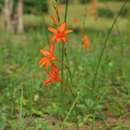zh-TW
在導航的名稱


Tritonia (flame freesia) is a genus of flowering plants in the iris family first described as a genus in 1802. They are naturally distributed across southern Africa, with a high concentration of species in Cape Province of western South Africa.[1] The genus is closely related to the genus Ixia.
Tritonia are small bulbous plants up to 80 cm, that appear in great numbers in spring. The leaves are fan-shaped. The flowers are shades of yellow, orange or brown, sweet-smelling, and give off a very strong fragrance, especially at night. They are not grazed.[2]
The genus name is derived from the Latin word triton, meaning "weathervane", and alludes to the apparently random arrangement of the stamens in some species.[3]
Hardiness: Zones 8–11
Tritonia (flame freesia) is a genus of flowering plants in the iris family first described as a genus in 1802. They are naturally distributed across southern Africa, with a high concentration of species in Cape Province of western South Africa. The genus is closely related to the genus Ixia.
Tritonia are small bulbous plants up to 80 cm, that appear in great numbers in spring. The leaves are fan-shaped. The flowers are shades of yellow, orange or brown, sweet-smelling, and give off a very strong fragrance, especially at night. They are not grazed.
The genus name is derived from the Latin word triton, meaning "weathervane", and alludes to the apparently random arrangement of the stamens in some species.